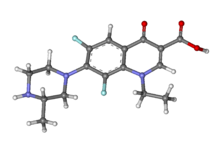Lomefloxacin
Appearance
This article relies largely or entirely on a single source. (August 2014) |
 | |
 | |
| Clinical data | |
|---|---|
| Trade names | Maxaquin |
| AHFS/Drugs.com | Consumer Drug Information |
| MedlinePlus | a600002 |
| ATC code | |
| Pharmacokinetic data | |
| Protein binding | 10% |
| Elimination half-life | 8 hours |
| Identifiers | |
| |
| CAS Number | |
| PubChem CID | |
| DrugBank | |
| ChemSpider | |
| UNII | |
| KEGG | |
| ChEBI | |
| ChEMBL | |
| CompTox Dashboard (EPA) | |
| ECHA InfoCard | 100.117.399 |
| Chemical and physical data | |
| Formula | C17H19F2N3O3 |
| Molar mass | 351.348 g/mol g·mol−1 |
| 3D model (JSmol) | |
| |
| |
| (verify) | |
Lomefloxacin hydrochloride (sold under the following brand names in English speaking countries Maxaquin, Okacyn, Uniquin) is a fluoroquinolone antibiotic used to treat bacterial infections including bronchitis and urinary tract infections. It is also used to prevent urinary tract infections prior to surgery. Lomefloxacin is associated with phototoxicity and central nervous system adverse effects.[1]
October 2008 the FDA added the following black box warning to the product insert for Maxaquin: Lomefloxacin is unique in that it forms a magnesium chelate with itself. The chelate is formed between the 2-carbonyl group of two separate lomefloxacin molecules.
See also
References
- ^ Rubinstein, E. (2001). "History of quinolones and their side effects". Chemotherapy. 47 (Suppl 3): 3–8, discussion 44–8. doi:10.1159/000057838. PMID 11549783.
